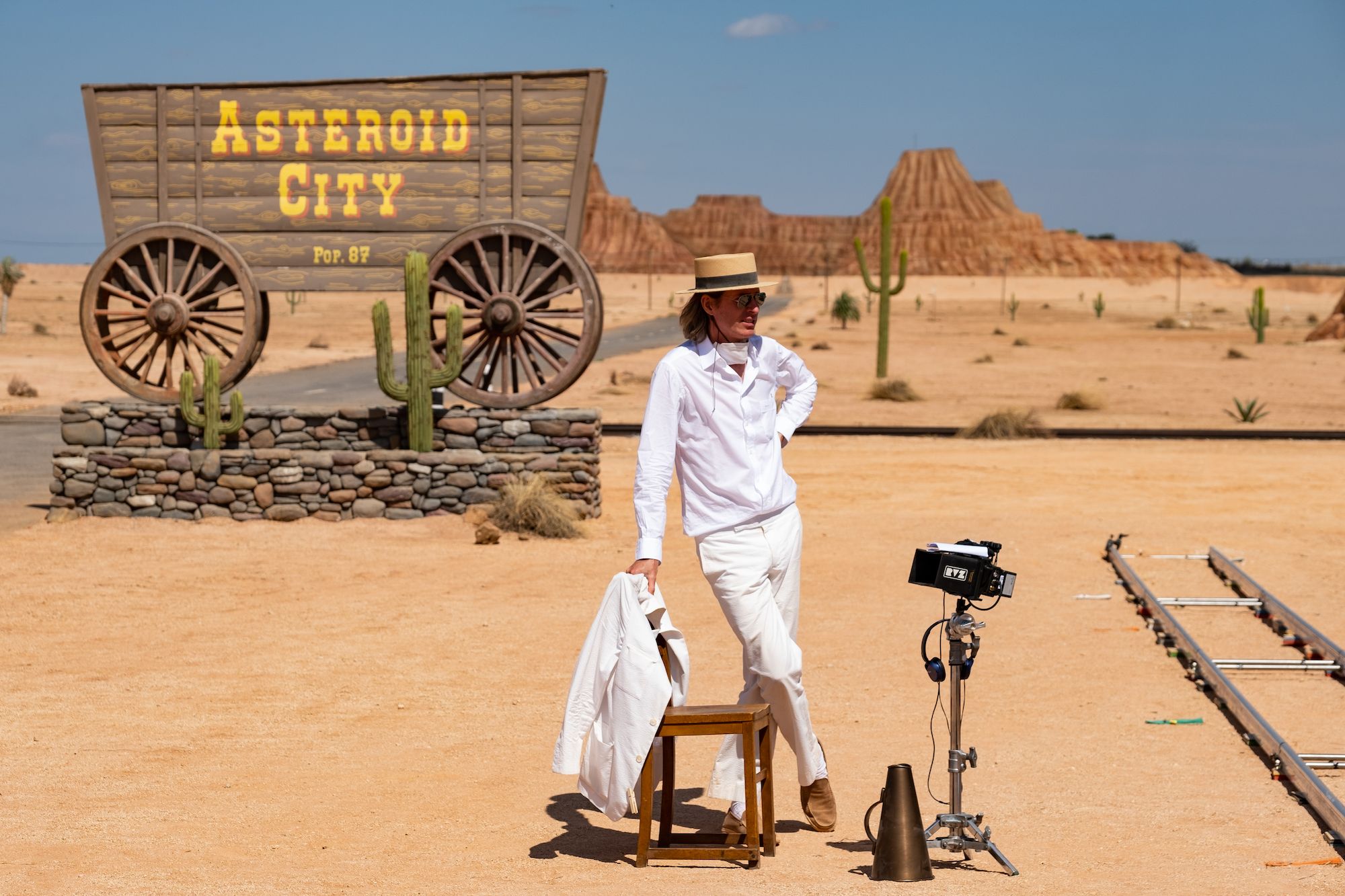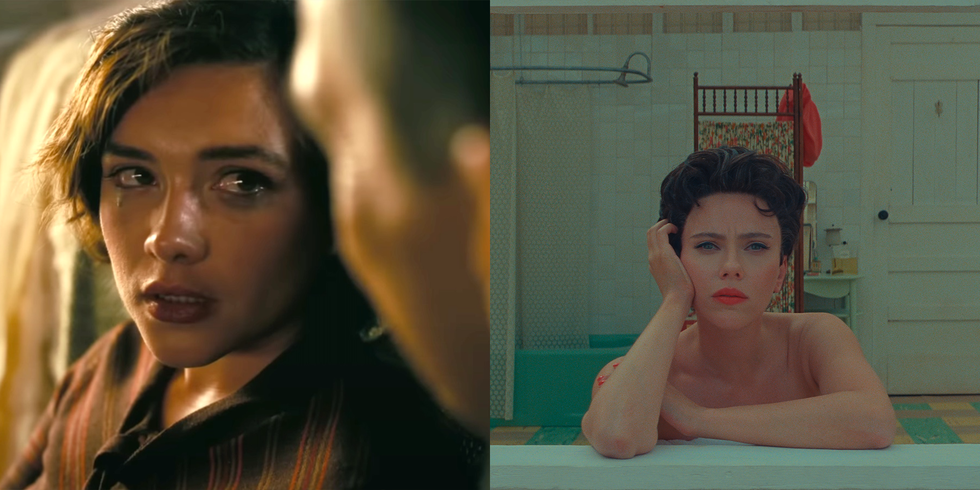It’s going to be hard not to start this piece with one of those cute bits where you sound like you’re describing one film when you’re actually writing about another: see every article about Barbie and Oppenheimer currently in existence. But all the time we were busy making droll comparisons between a film about a little blue-eyed sexpot with big ideas who mistakenly believes themselves to be making the world a better place and Barbie (cooee!), there was another adorable twosome under our noses the whole time.
In fact, while watching Christopher Nolan’s Oppenheimer earlier this week, there was another recent movie that kept springing to mind… Wes Anderson’s Asteroid City. Yes yes, Asteroid City, starring half of Hollywood, is a whimsical dramedy about a junior stargazing convention, and Christopher Nolan’s Oppenheimer, starring Cillian Murphy, is a meditative tragedy about the father of the atom bomb (although – sometimes weirdly – there are jokes). And yet, the films have more in common than might be immediately obvious. Ok that’s not true, many of the things they have in common are immediately obvious. Such as… (and yes, apologies, but this is happening):
1 | The scenery
Among J. Robert Oppenheimer’s numerous big ideas was placing the new town in which The Manhattan Project would secretly be hatched in the middle of the desert of his beloved New Mexico. As a town built from scratch, Los Alamos has something of the thrown-together movie-set about it, with the mesas of the Pajarito Plateau providing a dramatic backdrop. Asteroid City, meanwhile, is also a mid-century pioneer-town in the desert of the southwest (though filmed in Spain), where flimsy wooden buildings stand alongside dramatic (foam) rock formations. One down.
2 | The subterfuge
Asteroid City may look like a normal town, but actually there are strange goings-on. The meteorite that landed there 3,000 years earlier has provoked some extra-terrestrial attention, prompting a military lockdown of the permanent residents and visitors, under the command of gruff-but-loveable General Grif Gibson (Jeffrey Wright). In Oppenheimer, Los Alamos is also effectively shut off from the outside world, when gruff-but-loveable Lieutenant General Leslie Groves (Matt Damon) becomes concerned that someone is leaking atomic secrets to the Russians.
3 | The starry cameos
There are more than a couple of distracting bit-parts in Oppenheimer, not least Rami Malek, who for the first two hours looks like he might have been hired only to hold a clipboard, Gary Oldman, who chews up the Oval Office furniture as Harry S. Truman, and Tom Conti, who gives us a kind-eyed Einstein. The famously friendless Anderson had to make do only with Tilda Swinton, Tom Hanks, Jason Schwartzman, Scarlett Johansson, Adrien Brody, Bryan Cranston, Margot Robbie, Matt Dillon, Jeff Goldblum, Willem Defoe, Steve Carell… (etc, etc).
4 | The staginess
Lately, people have had the bit between their teeth about Anderson being “a stylist”: a director who predicates aesthetics over psychological or philosophical enquiry (as though cinema wasn’t primarily, you know, a visual medium). True, his actors aren’t giving huge verité energy, but that’s legitimised in Asteroid City at least because the actions in the desert are shown to be a play within a play; Edward Norton plays the tortured playwright whose efforts are being reported in an interspersed black-and-white television special.
Oppenheimer has a similar device operating, and in a similar way: J Robert’s memories appear in sumptuous colour, with grand dialogue (“You’re the great salesman of science; you can convince anyone of anything – including yourself”) playing just above Ludwig Göransson’s emotionally instructive score. Interspersed is a black-and-white representation of the subsequent hearing at which Robert Downey Jr’s scene-stealing Strauss, chairman of the US Atomic Energy Commission, undercuts the action as Oppenheimer recalls it.
5 | The sad ladies in lipstick
Oppenheimer boasts not one but two sad ladies – first Florence Pugh, as Oppy’s lover Jean Tatlock, and then Emily Blunt as his wife Kitty, whom he seduces with quantum physics, explaining how we deem matter to be “solid, to stop my body passing through yours” (but not for long, amiright, J!). Asteroid City has just the one – Scarlett Johansson as actress Midge Campbell – but she does at least, look like a true Hitchcockian goddess as she mopes over a giant bottle of Chanel No. 5.
6 | The set piece
All dramas, be they happy or sad, need a climax, and both Oppenheimer and Asteroid City look to the heavens for theirs. Asteroid City goes for alien visitors, who silence the chatter of the assembled townspeople with their cutesy, claymation presence, while for Oppenheimer, it is, of course, the staggeringly recreated testing of the atom bomb which causes the residents of Los Alamos to stare dumbstruck into their pieces of reflective glass. In both movies, the action is suspended, the starry casts silenced, and the audience left awestruck and reeling (especially if they don’t like stop-frame animation, wink wink!).
7 | The sub-text
There is, however, a link that is arguably more substantial than the others (hard to believe, we know), in that aliens and atomic bombs have gone together historically, too. Roswell, New Mexico, where an alien spaceship may or may not have crash-landed in 1947, was also the home of the 509th Bomb Group, an atomic bomber squadron. In fact, there have been hundreds of reported UFO sightings at nuclear weapons sites by US Air Force personnel. Was it symptomatic of the paranoia of the age? A sign that humanity was tinkering with things beyond its earthly remit? Anderson nods to that with the dull explosions happening in the distance during Asteroid City, and Cillian Murphy’s Oppy, the cosmos swirling in his eyes, is definitely seeing forces greater than our own. It’s like they’re onto something. Also, can we help it if all the entries in this article start with “S”? No we cannot. Sometimes, the universe speaks in mysterious ways.

Miranda Collinge is the Deputy Editor of Esquire, overseeing editorial commissioning for the brand. With a background in arts and entertainment journalism, she also writes widely herself, on topics ranging from Instagram fish to psychedelic supper clubs, and has written numerous cover profiles for the magazine including Cillian Murphy, Rami Malek and Tom Hardy.















